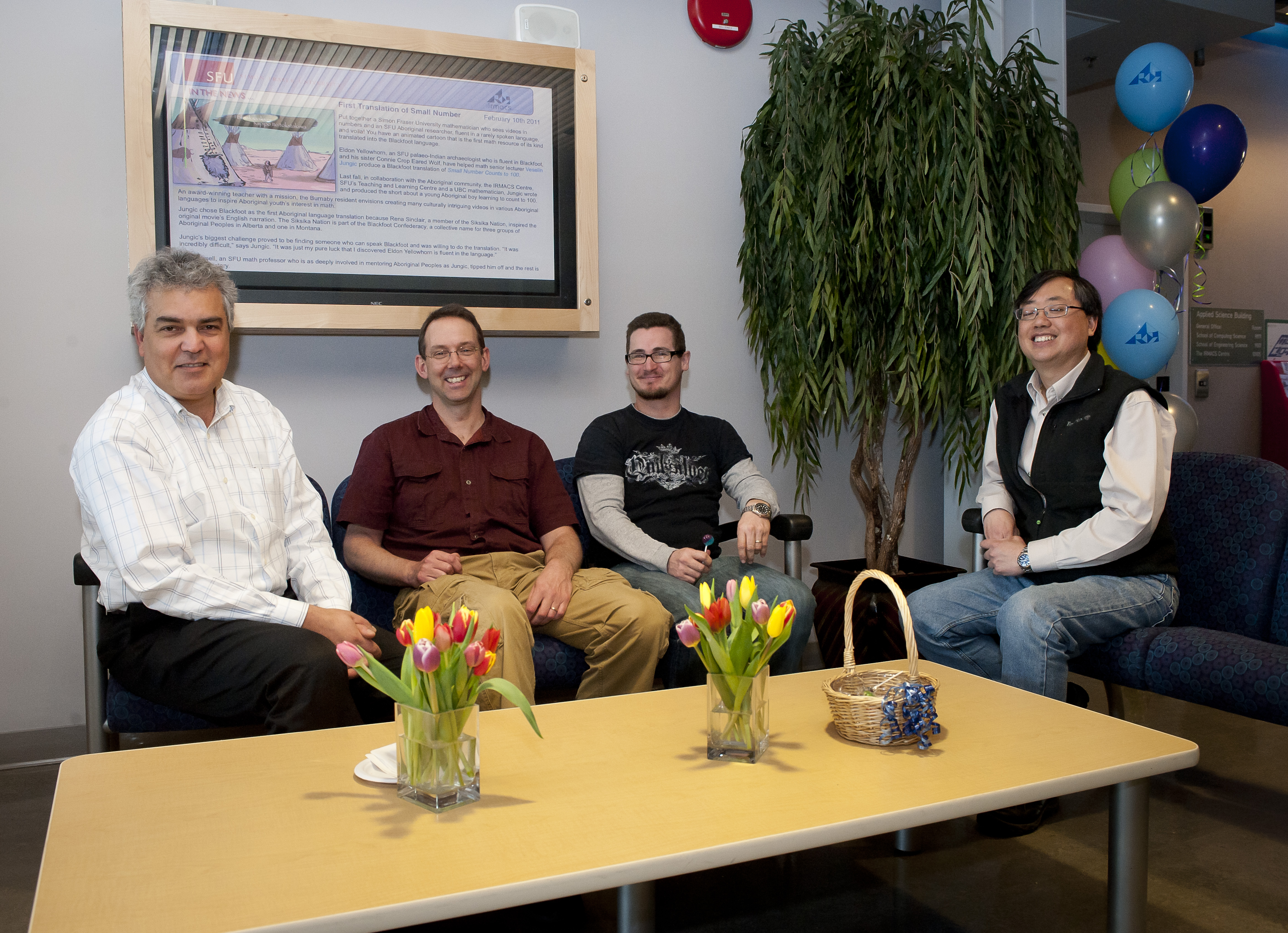8th Annual IRMACS Day & Open House

On Friday, April 12th, 2013, the IRMACS Centre will celebrate its 8th anniversary of operation.
This event is also dedicated to Dr. Peter Borwein, the Founding Director of the IRMACS Centre, on the occasion of his 60th birthday.
We are preparing a series of events, including the launch of our 2013 thematic year. All talks held in ASB 10900 will be live streamed at http://www.sfu.ca/irmacs-archive/irmacs/about/live-video.
The complete IRMACS Day schedule is as follows:
| 9:45 - 11:45 | MoCSSy Semester end Presentations - ASB 10900 |
| 9:45 - 10:00 | Opening of Semester End Presentations |
| 10:00 – 10:30 | Talk by Warren Hare, Assistant Professor, Mathematics and Statistics, UBC, Okanagan |
| 10:30 - 11:45 | MoCSSy Student Presentations |
| 11:45 - 12:10 | Open Forum discussion on Interdisciplinary Graduate Training |
| 12:10 - 12:15 | Break |
| 12:15 - 2:15 | Afternoon Presentations - ASB 10900 |
| 12:15 - 12:30 | Welcome by Veselin Jungic/Opening Remarks by Mario Pinto |
| 12:30 - 12:40 | Launch of IRMACS Thematic Year, Scholarship Award - Felix Breden |
| 12:40 – 12:55 | Peter Borwein's Contributions to Research – Stephen Choi |
| 12:55 – 1:05 | Peter Borwein’s Contributions to the Community – Derek Bingham |
| 1:05 - 1:15 | Break |
| 1:15 - 2:15 | Talk by Andrew Odlyzko, Professor, School of Mathematics, University of Minnesota |
| 2:15 - 3:30 | IRMACS Open House and Refreshments - IRMACS Atrium |
| 3:30 - 4:30 | PIMS/CSC Distinguished Lecture Series, talk by Tao Tang, Chair Professor, Department of Mathematics, Hong Kong Baptist University |
| 4:45 - 6:30 | IRMACS Day Reception honoring Dr. Peter Borwein |
About Dr. Hare's Talk:
Title: Using Mathematical Modelling and Optimization to Mitigate Earthquake Damage
Abstract: The damages observed from seismic pounding, i.e., heavy and repeated collision of buildings, are devastating. Earthquake-prone areas with high population density, such as the lower-mainland, are in particular danger. Fortunately, modern engineering has demonstrated that damper connectors can reduce pounding damage and increase the seismic resistance of a structure. Unfortunately, such connectors are very expensive and often intractable from a financial prospective. In this talk we explore how mathematical modelling and optimization can be used to design and place a limited number of dampers to mitigate earthquake damage. We find it is often possible to gain the effect of full retrofit using a very little number of dampers.
About the IRMACS Thematic Year: In its eight years of existence, through the provision of space, technical resources and expertise, the IRMACS Centre has played a major role in the wider SFU process of strengthening interdisciplinary research, education, and training. The main goal of the IRMACS 2013 Thematic Year "The Science and Technology of Interdisciplinary Collaboration" is to further promote interdisciplinary collaboration as a way to integrate theories, techniques, and tools from multiple scientific disciplines to solve problems whose solutions are out of reach of a single discipline.
About Dr. Odlyzko's Talk:
Title: Mathematical models: Uses, abuses, and non-uses
Abstract: Models are indispensable, but have to be used with caution. Some early quantitative models, drawn from the early history of British railways and related to the ubiquitous gravity models of transportation, urban planning, spacial economics, and related areas, will be presented. They demonstrate how even clearly false models can be useful, and how sometimes they are misused or tragically not used.
About Open House:
- Poster Presentation
- Math Catcher Outreach Program - Small Number animated films and activities - The Math Catcher Team
- 3D IQ Station demonstration - Dr. Brian Corrie
- Tree of Life - OneZoom demonstration - Dr. Jeffrey Joy
- Interactive Robotics - Dr. Shahram Payandeh
- Live 3D Stereoscopic Video Capture demonstration - Mr. Andy Gavel
- Visual Analytics - From Data to Knowledge software demonstration - The VIVA Team
... and much more!
About Dr. Tang's Talk:
Title: High-Order and Adaptive Time Stepping Methods for Energy Gradient Flows
Abstract: The phase-field method is very useful for modeling interfacial phenomena. The key idea of the phase-field methodology is to replace sharp interfaces by thin transition regions where interfacial forces are smoothly distributed. One of the main reasons for the success of the phase-field methodology is that it is based on rigorous mathematics and thermodynamics. Most phase-field models satisfy a nonlinear stability relationship, usually expressed as a time-decreasing free-energy functional, which is called energy gradient stability. To obtain accurate numerical solutions of such problems, it is desirable to use high-order approximations in space and time. Yet because of the difficulties introduced by the combination of nonlinearity and stiffness, most computations have been limited to lower-order in time, and in most cases to constant time-stepping. On the other hand, numerical simulations for many physical problems require large time integration; as a result large time-stepping methods become necessary in some time regimes.
Everyone is welcome!
Photos of the 8th Annual IRMACS Day
Contact: Veselin Jungic vjungic@irmacs.sfu.ca or Pam Borghardt pjborgha@irmacs.sfu.ca

